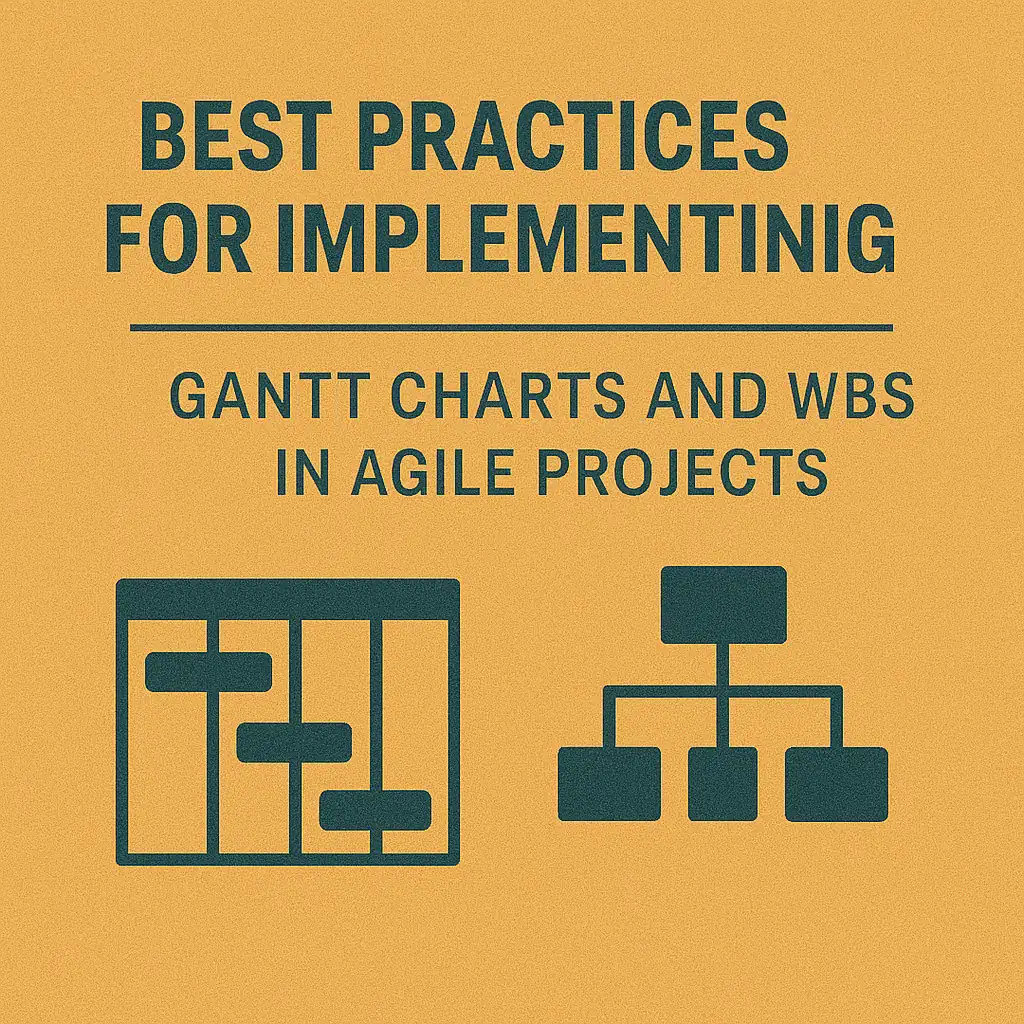Introduction
Gantt charts and Work Breakdown Structures (WBS) have long been recognized as essential tools for planning and tracking project progress.
- Gantt Chart: A Gantt chart is a visual representation that uses bars to illustrate the timeline of project activities, showcasing the start and end dates of tasks, their duration, and dependencies between them. This tool allows project managers to see the overall project timeline at a glance, making it easier to identify potential bottlenecks and overlaps in scheduling [12].
- Work Breakdown Structure (WBS): Conversely, a WBS is a hierarchical decomposition of a project into smaller, manageable components or tasks. It serves as a framework for organizing and defining the total scope of a project, breaking it down into phases, deliverables, and individual tasks [15]. This structured approach helps ensure that all aspects of the project are accounted for and facilitates better resource allocation and task assignment.
Traditionally, Gantt charts and WBS have been utilized in more linear project management methodologies, such as Waterfall, where projects are planned in detail upfront and executed in a sequential manner. These tools provide clarity and structure, allowing project managers to meticulously plan each phase and monitor progress against the established timeline [2][10].
However, with the rise of Agile project management, which emphasizes flexibility, iterative progress, and responsiveness to change, the application of these traditional tools requires adaptation. Agile methodologies prioritize collaboration, customer feedback, and rapid delivery of functional components, often leading to a more dynamic project environment where requirements can evolve throughout the project lifecycle [3][4].
The necessity of adapting Gantt charts and WBS in Agile environments stems from the need to maintain structure while embracing the fluidity of Agile practices. Agile project managers and Scrum Masters can leverage these tools to enhance visibility and communication within their teams, ensuring that everyone is aligned on project goals and timelines, even as they navigate the complexities of iterative development [8][9]. By integrating Gantt charts and WBS into Agile frameworks, teams can achieve a balance between structured planning and the adaptability that Agile methodologies demand.
Understanding Gantt Charts
Gantt charts are essential tools in project management that provide a visual representation of a project’s schedule. They are particularly useful for Agile project managers and Scrum Masters who seek to adapt traditional project management methodologies to fit within Agile frameworks. Here’s a closer look at the components, visualization capabilities, benefits, and limitations of Gantt charts.
Components of a Gantt Chart
A Gantt chart typically consists of the following key components:
- Tasks: These are the individual activities or work items that need to be completed within the project. Each task is represented as a horizontal bar on the chart.
- Timelines: The horizontal axis of the Gantt chart represents the timeline of the project, showing the start and end dates for each task. This allows project managers to see when tasks are scheduled to begin and finish.
- Dependencies: Gantt charts also illustrate the relationships between tasks, indicating which tasks are dependent on the completion of others. This is crucial for understanding the sequence of activities and managing potential bottlenecks in the project workflow [2][10].
Visualizing Project Schedules
Gantt charts excel at visualizing project schedules by providing a clear and organized layout. The visual format allows project managers to quickly assess the overall timeline of the project, identify overlapping tasks, and understand how different activities interconnect. This clarity is particularly beneficial in Agile environments where rapid changes and iterations are common. By linking dependencies and milestones, Gantt charts help teams maintain a comprehensive view of project progress and timelines [7][10].
Benefits of Using Gantt Charts
The implementation of Gantt charts in project management offers several advantages:
- Tracking Progress: Gantt charts enable project managers to monitor the progress of tasks against the planned schedule. This tracking capability helps in identifying delays and making necessary adjustments to keep the project on track [8][10].
- Resource Allocation: By visualizing the timeline and task dependencies, Gantt charts assist in effective resource allocation. Project managers can see which resources are assigned to specific tasks and ensure that workloads are balanced across the team [10].
- Enhanced Communication: Gantt charts serve as a communication tool among team members and stakeholders, providing a shared understanding of project timelines and responsibilities. This transparency fosters collaboration and alignment within the team [10].
Limitations in a Purely Agile Context
While Gantt charts offer numerous benefits, they also have limitations when applied in a purely Agile context:
- Rigidity: Gantt charts are often seen as rigid tools that may not accommodate the fluid nature of Agile methodologies. Agile projects thrive on flexibility and adaptability, which can be at odds with the fixed timelines and dependencies represented in Gantt charts [12][13].
- Overemphasis on Planning: In Agile environments, the focus is on iterative development and responding to change rather than extensive upfront planning. Gantt charts may lead teams to spend too much time on planning and scheduling, detracting from the Agile principle of delivering working software quickly [12][13].
- Complexity in Dynamic Environments: As Agile projects evolve, the initial Gantt chart may quickly become outdated, requiring frequent updates to reflect changes in tasks and timelines. This can create additional overhead for project managers [12][13].
Exploring Work Breakdown Structure (WBS)
In Agile frameworks, the Work Breakdown Structure (WBS) serves as a foundational tool that aids in effectively managing project scope and ensuring successful delivery. Here, we delve into the WBS methodology, its significance in project planning, and its adaptation to Agile environments.
Defining WBS and Its Role in Project Scope Management
A Work Breakdown Structure (WBS) is a visual project management technique that organizes a project into manageable sections, breaking it down into smaller, more digestible tasks and deliverables. This hierarchical decomposition allows project managers to define the project scope clearly, ensuring that all aspects of the project are accounted for and understood by the team. By providing a structured overview, WBS helps in aligning the project goals with the necessary tasks required for completion, thus facilitating better scope management [12][13].
Hierarchical Decomposition of Project Tasks
The WBS methodology involves listing project tasks vertically, creating a tree-like structure that illustrates the relationship between the overall project and its individual components. This hierarchical representation not only clarifies the project’s scope but also aids in identifying dependencies among tasks. Each level of the WBS breaks down the project further, allowing teams to focus on specific areas without losing sight of the overall objectives. This structured approach is particularly beneficial in Agile projects, where flexibility and adaptability are key, as it provides a clear roadmap while still allowing for iterative progress [2][4][14].
Identifying Deliverables and Milestones
One of the primary advantages of utilizing a WBS is its effectiveness in identifying deliverables and milestones throughout the project lifecycle. By breaking down the project into smaller tasks, teams can easily pinpoint critical deliverables and set realistic milestones that align with Agile principles. This clarity not only enhances communication among team members but also ensures that everyone is aware of their responsibilities and the timeline for completion. As a result, the WBS acts as a guiding framework that supports Agile teams in maintaining focus on their goals while adapting to changes as they arise [9][12].
Challenges of WBS in Agile Environments
Despite its benefits, implementing a WBS in Agile projects can present certain challenges. One significant issue is the potential rigidity that a traditional WBS may impose on the Agile process. Agile methodologies thrive on flexibility and responsiveness to change, while a WBS can sometimes create a perception of a fixed plan that may not accommodate evolving project requirements. This rigidity can lead to resistance from team members who are accustomed to the fluid nature of Agile practices. Therefore, it is crucial for Agile project managers and Scrum Masters to adapt the WBS approach, ensuring it complements Agile principles rather than constraining them. This may involve using a more dynamic version of WBS that allows for iterative updates and adjustments as the project progresses [3][11][15].
Adapting Gantt Charts for Agile Projects
The integration of traditional tools like Gantt charts and Work Breakdown Structures (WBS) can enhance clarity and organization while maintaining the flexibility that Agile methodologies demand. Here are some practical strategies for adapting Gantt charts within an Agile framework:
Iterative Planning and Flexible Scheduling
- Embrace Iterative Planning: Agile projects thrive on iterative cycles, often referred to as sprints. Gantt charts can be modified to reflect these iterations by breaking down the project timeline into smaller, manageable segments. This allows teams to visualize progress and adjust plans based on feedback and changing requirements, aligning with Agile principles of adaptability and responsiveness [10].
- Flexible Scheduling: Traditional Gantt charts often depict a fixed timeline, which can be counterproductive in Agile environments. To accommodate the dynamic nature of Agile, consider using Gantt charts that allow for easy rescheduling of tasks. This can be achieved by enabling drag-and-drop functionality for task bars, making it simple to adjust timelines as priorities shift [3].
Modifications for Sprints and Incremental Delivery
- Incorporate Sprints: Modify Gantt charts to represent sprints clearly. Each sprint can be visualized as a distinct phase within the Gantt chart, with tasks and milestones aligned to the sprint goals. This helps teams focus on short-term objectives while keeping the overall project timeline in view [11].
- Highlight Incremental Deliveries: Use Gantt charts to mark key deliverables at the end of each sprint. This not only provides a visual representation of progress but also reinforces the Agile principle of delivering value incrementally. By showcasing these milestones, teams can maintain momentum and ensure that stakeholders are aware of the project’s evolution [10].
Stakeholder Communication
- Enhance Communication: Gantt charts can serve as effective communication tools for stakeholders in Agile projects. By providing a visual timeline of tasks, dependencies, and milestones, Gantt charts facilitate discussions around project status and expectations. Regular updates to the Gantt chart can help keep stakeholders informed and engaged, fostering transparency and collaboration [4].
- Color-Coding and Labeling: Implement color-coding or labeling within Gantt charts to differentiate between various tasks, sprints, or team responsibilities. This visual distinction can make it easier for stakeholders to navigate the chart and understand the project’s current state at a glance [9].
Agile-Friendly Gantt Chart Tools
- Select Appropriate Tools: There are several Gantt chart tools designed with Agile methodologies in mind. Look for software that offers features such as:
- Integration with Agile frameworks: Tools that support Scrum or Kanban methodologies can provide a more seamless experience.
- Real-time collaboration: Choose tools that allow team members to update tasks and timelines in real-time, ensuring everyone is on the same page.
- Customizable views: Opt for Gantt chart tools that allow for customization to fit the specific needs of your Agile project, such as adjusting timelines for sprints or highlighting key deliverables [15].
By thoughtfully integrating Gantt charts into Agile project management, teams can leverage the strengths of both traditional and modern methodologies. This approach not only enhances project visibility and stakeholder communication but also supports the iterative and flexible nature of Agile practices.
Integrating WBS into Agile Methodologies
Incorporating a Work Breakdown Structure (WBS) into Agile project management can enhance clarity and organization while maintaining the flexibility that Agile methodologies promote. Here are some best practices for effectively integrating WBS into Agile projects:
Creating a WBS that Aligns with Agile Values
- Simplicity and Clarity: When developing a WBS for Agile projects, it is crucial to keep it simple. The WBS should break down the project into manageable components without overcomplicating the structure. This aligns with Agile values by ensuring that the team can easily understand and adapt the WBS as the project evolves [14].
- Adaptability: Agile projects are characterized by their ability to adapt to change. Therefore, the WBS should be designed to accommodate modifications as new information emerges or project requirements shift. This means creating a WBS that is not overly rigid, allowing for the addition or removal of tasks as needed [14].
Iterative Development and Refining the WBS Over Sprints
- Continuous Refinement: Agile emphasizes iterative development, which can be applied to the WBS as well. Teams should regularly review and refine the WBS during sprint planning sessions. This iterative approach allows the WBS to evolve alongside the project, ensuring it remains relevant and useful throughout the development process [1].
- Feedback Loops: Incorporating feedback from team members during retrospectives can help identify areas for improvement in the WBS. This practice not only enhances the WBS but also fosters a culture of continuous improvement within the team [1].
Continuous Refinement: Agile emphasizes iterative development, which can be applied to the WBS as well. Teams should regularly review and refine the WBS during sprint planning sessions. This iterative approach allows the WBS to evolve alongside the project, ensuring it remains relevant and useful throughout the development process [1].
Importance of Collaboration and Team Input in WBS Creation
- Team Involvement: Collaboration is a cornerstone of Agile methodologies. Engaging the entire team in the WBS creation process ensures that all perspectives are considered, leading to a more comprehensive and effective breakdown of tasks. This collaborative effort can also enhance team ownership and accountability for the project [11].
- Workshops and Brainstorming Sessions: Organizing workshops or brainstorming sessions can facilitate team input in developing the WBS. These sessions encourage open communication and allow team members to contribute their insights, which can lead to a more robust and well-rounded WBS [11].
Case Studies or Examples of Successful WBS Integration in Agile
- Example 1: Software Development Project: In a software development project, a team utilized a WBS to outline key features and functionalities. By breaking down the project into user stories and tasks, the team was able to prioritize work effectively and adapt to changing requirements during sprints. This approach not only improved transparency but also enhanced the team’s ability to deliver value incrementally [12].
- Example 2: Marketing Campaign: A marketing team integrated a WBS to manage a campaign launch. By involving all stakeholders in the WBS creation process, they ensured that all marketing activities were accounted for and aligned with the overall project goals. The iterative refinement of the WBS allowed the team to pivot quickly in response to market feedback, leading to a successful campaign launch [12].
Best Practices for Using Gantt Charts and WBS in Agile
The integration of traditional tools like Gantt charts and Work Breakdown Structures (WBS) can enhance clarity and organization while maintaining the flexibility that Agile methodologies promote. Here are some effective strategies for combining these tools in Agile projects:
- Encourage Continuous Improvement and Feedback Loops: Agile emphasizes iterative progress and adaptability. By utilizing Gantt charts, teams can visualize project timelines and milestones, allowing for regular reviews and adjustments based on feedback. This practice aligns with Agile principles, fostering a culture of continuous improvement where teams can refine their processes and outputs based on real-time insights [3][5].
- Promote Transparency and Visibility: Both Gantt charts and WBS serve to enhance transparency within the project. Gantt charts provide a visual representation of the project schedule, making it easier for team members and stakeholders to understand task dependencies and timelines [11][12]. Meanwhile, a WBS breaks down the project into manageable components, ensuring that everyone is aware of their responsibilities and the overall project scope. This dual approach helps maintain visibility across all levels of the project, facilitating better collaboration and accountability [10][14].
- Highlight the Importance of Stakeholder Engagement and Communication: Effective communication is crucial in Agile environments. Gantt charts can be used to communicate project progress to stakeholders, while WBS can help clarify the scope and deliverables. Regular updates and discussions around these tools can engage stakeholders, ensuring their needs and expectations are met throughout the project lifecycle [4][14]. This engagement not only builds trust but also encourages stakeholder input, which can lead to more successful project outcomes.
- Suggest Training and Resources for Team Members: To maximize the effectiveness of Gantt charts and WBS, it is essential to provide training and resources for team members. Familiarity with these tools can significantly enhance their ability to contribute to project planning and execution. Offering workshops, online courses, or access to templates can empower team members to utilize these tools effectively, ultimately leading to improved project management practices [2][15].
By implementing these best practices, Agile project managers and Scrum Masters can effectively adapt traditional project management tools to fit within an Agile framework, enhancing both project delivery and team collaboration.
Conclusion
The integration of traditional tools such as Gantt charts and Work Breakdown Structures (WBS) can significantly enhance project planning and execution. Here are the key takeaways from our discussion:
- Complementary Roles: Gantt charts and WBS serve distinct yet complementary roles in Agile projects. While WBS helps in breaking down the project into manageable components, Gantt charts provide a visual timeline that tracks progress and dependencies, making it easier to communicate with stakeholders and manage expectations effectively [1][14].
- Flexibility and Adaptability: The essence of Agile lies in its flexibility. Agile Project Managers and Scrum Masters are encouraged to adapt these traditional tools to fit the iterative nature of Agile methodologies. By doing so, they can maintain a clear overview of project timelines while allowing for the necessary adjustments that Agile demands [12][15].
- Enhanced Collaboration: Utilizing Gantt charts alongside WBS fosters better collaboration among team members. It allows for a shared understanding of project goals and timelines, which is crucial in a fast-paced Agile environment [10][11].
As Agile Project Managers and Scrum Masters, embracing adaptability is vital. The ability to modify traditional project management tools to suit Agile practices not only enhances project efficiency but also empowers teams to respond swiftly to changes.
Find out more about Shaun Stoltz https://www.shaunstoltz.com/about/.
This post was written by an AI and reviewed/edited by a human.



